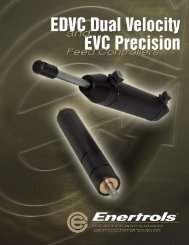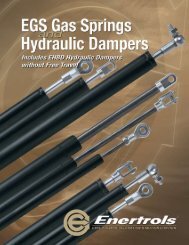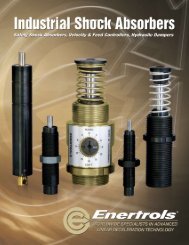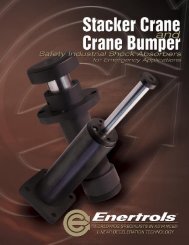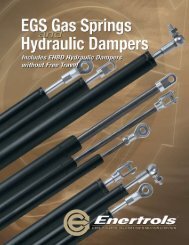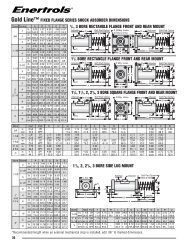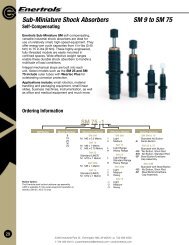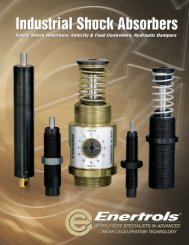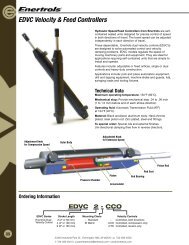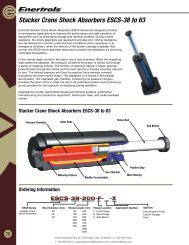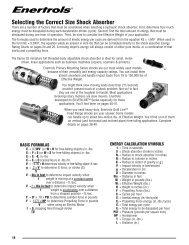Standard Shock Absorbers - JHBennett.com
Standard Shock Absorbers - JHBennett.com
Standard Shock Absorbers - JHBennett.com
- No tags were found...
You also want an ePaper? Increase the reach of your titles
YUMPU automatically turns print PDFs into web optimized ePapers that Google loves.
Selecting the Correct Model <strong>Shock</strong> AbsorberThe Model type of an Enertrols shock absorber is determined by:■ Type of accumulator—self-contained or external air/oil tank(AOT)■ Method of piston rod return—spring, air, or mechanicalModel and mounting selection are usually determined by theapplication. Self-contained models are generally preferredover the external accumulator-equipped models. They arepre-filled at the factory and ready to use when received. Noexternal piping or other system <strong>com</strong>ponents are required.Because Enertrols shocks stop a moving object in less timethan non-linear decelerating devices, you should select a unitwith the longest possible stroke that can be ac<strong>com</strong>modated(without exceeding side-loading limits; see page 48). This willminimize impact forces on the mounting structure and themoving object being stopped.ACCUMULATORSBASIC MODEL DESIGNATIONSType ofMethod ofAccumulator Piston Rod ReturnModelInternal Spring SAInternal Spring SALDExternal Air (or Mechanical) ALDInternal Mechanical ALDAExternal Spring ALDSInternal Spring (non-adjustable) SMInternal Spring (non-adjustable) SNALDExternal Air or Mech. (non-adjustable) NALDInternal Spring (SILVERLINE) SASLExternal Air (SILVERLINE) ASLExternal Spring (SILVERLINE) ASLSInternal Mechanical (SILVERLINE) ASLAWith internal accumulator models, the fluid displaced by the piston rod under impact is forced against a nitrogen-filled, closedcellsponge in the body of the shock absorber. As the piston rod is returned, the sponge expands to help force fluid back intothe high-pressure tube. Where conditions permit, internal accumulator models are preferred.Where more energy per hour (E 4), or heat dissipation is needed, as found in high duty-cycle applications, or high-temperatureenvironments, external accumulator models should be used. The external accumulator is a tank or reservoir, either open orclosed to atmosphere, that is connected to the shock absorber with appropriate size piping. The oil flows back and forthbetween it and the shock absorber, helping to cool the oil as the unit is cycled. The air/oil tank (AOT) of external accumulatorequippedmodels must be above the shock absorber and should be located as close to the shock absorber as possible.A 10-micron filter, installed between the exit of the air/oil tank and the shock absorber, is re<strong>com</strong>mended.If the AOT must be located at a substantial distance from the shock use a positive oil recirculation circuit (Fig. 2B).Otherwise, oil may simply move back and forth in the lines and never reach the tank to be cooled.PISTON ROD RETURNThe return of the piston rod is ac<strong>com</strong>plished in one of three ways (spring, air/oil, or mechanically). Mechanical returns usuallymake use of clevis-mounting designs and may be operated by a lever arm actuated by some other moving part of theequipment. On self-contained models, or air/oil models with a spring, an externally mounted spring returns the rod when theload is removed.In external accumulator models, an air/oil system, or some other mechanical means, must be used to return the piston rod.ALD models permit a variable rate of rod return, time delay and/or lower rod return forces. This is ac<strong>com</strong>plished by adding apressure regulator (Fig. 2B) to the air/oil system, or by addingFIGURE 2a 3-way valve and pressure regulator (Fig. 2C) to the system.ALDS models are shipped with a rod return spring installed.Thus, even when an external accumulator is used to improve heatdissipation, it need not be pressurized. The spring will providethe necessary rod return force. For best results, the accumulatorshould be vented to atmosphere with a filter/breather unit.A B CRe<strong>com</strong>mended air pressure for air oil tanks is 70-100 psidepending on the application.All mounting options for theEnertrols Gold Line andSILVERLINE Primary MountSeries are shown here. From left toright they are: Front Flange, Clevis,Basic Primary, Lug (Foot Mount)and Rear Flange.17




